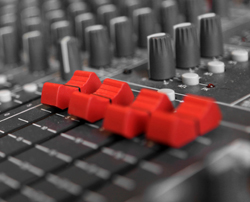
Working It
In no particular order, here are a few other things I’ve done over the years to get around noise limits.
None of these involve sabotage or any sort of overt rule breaking – it’s all about working the situation to our advantage.
Frankly, some of these things can only be pulled off as a headline engineer or when touring with a system, but hey, good ideas have a way of catching on.
The most obvious way to get more level when pinned under an A-weighted reading is to dull down the mix in the 2K to 4K range.
If the measurement mic is up high and you’re using a line array system, figure out which boxes are pointed at the mic, and then turn down (or off ) the mid drivers in those cabinets. This can buy you more of a “rock” factor.
When the mic is off to one side, turn down that side of the PA, and turn the other side up the same amount. Yes, the stereo imaging shifts, but it adds an extra dB or so in volume.
Cranking up delay clusters that are outside of the measurement zone is simple enough. If the measurement mic is low to the ground, get the band manager to stand in front of the mic after a few songs into the set. This not only helps lower the reading, but also lets the top brass know that you’re on your game while also getting you out of the line of fire, so to speak.
With many subwoofer setups, there’s a power alley, and then to each side, there’s a significant low-end null. Though we don’t like these nulls, we can use them to our advantage. By slightly delaying the subs on one side, a null can be steered right on top of the measurement mic. This will get you a few more dB with A-weighted measurements, and even more with C- and Flat-weighted measurements.
With off-site readings, something as simple as turning down (or off ) the side hang pointed in that direction can help. Killing sound to the top boxes in an array can also help – walk the space to figure out if there are even going to be people where those boxes are pointed during your show. Heck, turn off all the boxes you don’t need!
If you’re carrying production, flying the PA as high as feasible and using a more drastic down tilt causes sound to bounce upward rather than skim across the ground for longer distances.
In a worst case scenario with a low limit C-weighted measurement at front of house, I will go to the extreme of flipping polarity of the subs on one side of stage, which creates a distinct low-end hole down the center. This at least gets some volume to the other three-quarters of the venue.
